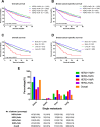Impact of molecular subtypes on metastatic breast cancer patients: a SEER population-based study
- PMID: 28345619
- PMCID: PMC5366953
- DOI: 10.1038/srep45411
Impact of molecular subtypes on metastatic breast cancer patients: a SEER population-based study
Abstract
To investigate the significance and impact of molecular subtyping stratification on metastatic breast cancer patients, we identified 159,344 female breast cancer patients in the Surveillance, Epidemiology and End Results (SEER) database with known hormone receptor (HoR) and human epidermal growth factor receptor 2 (HER2) status. 4.8% of patients were identified as having stage IV disease, and were more likely to be HER2+/HoR-, HER2+/HoR+, or HER2-/HoR-. Stage IV breast cancer patients with a HER2+/HoR+ status exhibited the highest median overall survival (OS) (44.0 months) and those with a HER2-/HoR- status exhibited the lowest median OS (13.0 months). Patients with a HER2-/HoR+ status had more bone metastasis, whereas patients with a HER2+/HoR- status had an increased incidence of liver metastasis. Brain and lung metastasis were more likely to occur in women with a HER2-/HoR- status. The multivariable analysis revealed a significant interaction between single metastasis and molecular subtype. No matter which molecular subtype, women who did not undergo primary tumour surgery had worse survival than those who experienced primary tumour surgery. Collectively, our findings advanced the understanding that molecular subtype might lead to more tailored and effective therapies in metastatic breast cancer patients.
Conflict of interest statement
The authors declare no competing financial interests.
Figures



Similar articles
-
Would 1.0 cm be a more suitable cutoff to subdivide pT1 tumors in hormone receptor-negative and HER2-positive breast cancer?Cancer Med. 2018 Nov;7(11):5420-5430. doi: 10.1002/cam4.1785. Epub 2018 Oct 1. Cancer Med. 2018. PMID: 30277006 Free PMC article.
-
ER+/HER2+ Breast Cancer Has Different Metastatic Patterns and Better Survival Than ER-/HER2+ Breast Cancer.Clin Breast Cancer. 2019 Aug;19(4):236-245. doi: 10.1016/j.clbc.2019.02.001. Epub 2019 Feb 14. Clin Breast Cancer. 2019. PMID: 30846407
-
Breast cancer subtypes predict the preferential site of distant metastases: a SEER based study.Oncotarget. 2017 Apr 25;8(17):27990-27996. doi: 10.18632/oncotarget.15856. Oncotarget. 2017. PMID: 28427196 Free PMC article.
-
Estrogen, progesterone, and HER2/neu receptor discordance between primary and metastatic breast tumours-a review.Cancer Metastasis Rev. 2016 Sep;35(3):427-37. doi: 10.1007/s10555-016-9631-3. Cancer Metastasis Rev. 2016. PMID: 27405651 Review.
-
Prognostic value of HER2-low status in breast cancer: a systematic review and meta-analysis.ESMO Open. 2023 Aug;8(4):101592. doi: 10.1016/j.esmoop.2023.101592. Epub 2023 Jul 4. ESMO Open. 2023. PMID: 37413762 Free PMC article.
Cited by
-
Comparison of the clinicopathological characteristics and prognosis between Chinese patients with breast cancer with bone-only and non-bone-only metastasis.Oncol Lett. 2020 Oct;20(4):92. doi: 10.3892/ol.2020.11953. Epub 2020 Aug 6. Oncol Lett. 2020. PMID: 32831911 Free PMC article.
-
Ki67 and PR in Patients Treated with CDK4/6 Inhibitors: A Real-World Experience.Diagnostics (Basel). 2020 Aug 8;10(8):573. doi: 10.3390/diagnostics10080573. Diagnostics (Basel). 2020. PMID: 32784518 Free PMC article.
-
Modeling Brain Metastases Through Intracranial Injection and Magnetic Resonance Imaging.J Vis Exp. 2020 Jun 7;(160):10.3791/61272. doi: 10.3791/61272. J Vis Exp. 2020. PMID: 32568247 Free PMC article.
-
Quantitative high-throughput analysis of tumor infiltrating lymphocytes in breast cancer.Front Oncol. 2022 Sep 5;12:901591. doi: 10.3389/fonc.2022.901591. eCollection 2022. Front Oncol. 2022. PMID: 36132149 Free PMC article.
-
Efficacy and safety of palbociclib plus endocrine therapy in North American women with hormone receptor-positive/human epidermal growth factor receptor 2-negative metastatic breast cancer.Breast J. 2020 Mar;26(3):368-375. doi: 10.1111/tbj.13516. Epub 2019 Aug 25. Breast J. 2020. PMID: 31448513 Free PMC article. Clinical Trial.
References
-
- Torre L. A. et al.. Global cancer statistics, 2012. CA-Cancer J Clin 65, 87–108 (2015). - PubMed
-
- DeSantis C. E. et al.. Breast cancer statistics, 2015: convergence of incidence rates between black and white women. CA-Cancer J Clin, 66, 31–42 (2016). - PubMed
-
- Carey L. A. et al.. Race, breast cancer subtypes, and survival in the Carolina Breast Cancer Study. JAMA 295, 2492–2502 (2006). - PubMed
-
- Perou C. M. et al.. Molecular portraits of human breast tumours. Nature 406, 747–752 (2000). - PubMed
-
- Fan C. et al.. Concordance among gene-expression–based predictors for breast cancer. N Engl J Med 355, 560–569 (2006). - PubMed
Publication types
MeSH terms
Substances
LinkOut - more resources
Full Text Sources
Other Literature Sources
Medical
Research Materials
Miscellaneous

